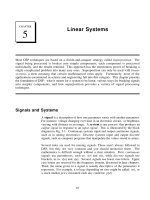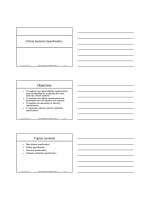Critical Systems Specification
Bạn đang xem bản rút gọn của tài liệu. Xem và tải ngay bản đầy đủ của tài liệu tại đây (97.39 KB, 17 trang )
©Ian Sommerville 2004 Software Engineering, 7th edition. Chapter 9 Slide 1
Critical Systems Specification
©Ian Sommerville 2004 Software Engineering, 7th edition. Chapter 9 Slide 2
Objectives
To explain how dependability requirements
may be identified by analysing the risks
faced by critical systems
To explain how safety requirements are
generated from the system risk analysis
To explain the derivation of security
requirements
To describe metrics used for reliability
specification
©Ian Sommerville 2004 Software Engineering, 7th edition. Chapter 9 Slide 3
Topics covered
Risk-driven specification
Safety specification
Security specification
Software reliability specification
©Ian Sommerville 2004 Software Engineering, 7th edition. Chapter 9 Slide 4
Dependability requirements
Functional requirements to define error
checking and recovery facilities and
protection against system failures.
Non-functional requirements defining the
required reliability and availability of the
system.
Excluding requirements that define states
and conditions that must not arise.
©Ian Sommerville 2004 Software Engineering, 7th edition. Chapter 9 Slide 5
Risk-driven specification
Critical systems specification should be risk-
driven.
This approach has been widely used in
safety and security-critical systems.
The aim of the specification process should
be to understand the risks (safety, security,
etc.) faced by the system and to define
requirements that reduce these risks.
©Ian Sommerville 2004 Software Engineering, 7th edition. Chapter 9 Slide 6
Stages of risk-based analysis
Risk identification
• Identify potential risks that may arise.
Risk analysis and classification
• Assess the seriousness of each risk.
Risk decomposition
• Decompose risks to discover their potential root causes.
Risk reduction assessment
• Define how each risk must be taken into eliminated or
reduced when the system is designed.
©Ian Sommerville 2004 Software Engineering, 7th edition. Chapter 9 Slide 7
Risk-driven specification
Risk analysis and
classification
Risk reduction
assessment
Risk
assessment
Dependability
requirements
Risk
decomposition
Root cause
analysis
Risk
description
Risk
identification
©Ian Sommerville 2004 Software Engineering, 7th edition. Chapter 9 Slide 8
Risk identification
Identify the risks faced by the critical system.
In safety-critical systems, the risks are the hazards
that can lead to accidents.
In security-critical systems, the risks are the
potential attacks on the system.
In risk identification, you should identify risk classes
and position risks in these classes
• Service failure;
• Electrical risks;
• …
©Ian Sommerville 2004 Software Engineering, 7th edition. Chapter 9 Slide 9
Insulin pump risks
Insulin overdose (service failure).
Insulin underdose (service failure).
Power failure due to exhausted battery (electrical).
Electrical interference with other medical equipment
(electrical).
Poor sensor and actuator contact (physical).
Parts of machine break off in body (physical).
Infection caused by introduction of machine
(biological).
Allergic reaction to materials or insulin (biological).
©Ian Sommerville 2004 Software Engineering, 7th edition. Chapter 9 Slide 10
Risk analysis and classification
The process is concerned with
understanding the likelihood that a risk will
arise and the potential consequences if an
accident or incident should occur.
Risks may be categorised as:
• Intolerable. Must never arise or result in an accident
• As low as reasonably practical(ALARP). Must minimise
the possibility of risk given cost and schedule constraints
• Acceptable. The consequences of the risk are acceptable
and no extra costs should be incurred to reduce hazard
probability
©Ian Sommerville 2004 Software Engineering, 7th edition. Chapter 9 Slide 11
Levels of risk
Unaccepta ble r egion
Risk cannot be toler ated
Risk toler ated onl y if
risk reduction is impr actical
or g rossly e xpensive
Acceptab le
region
Negligible risk
ALARP
region
©Ian Sommerville 2004 Software Engineering, 7th edition. Chapter 9 Slide 12
Social acceptability of risk
The acceptability of a risk is determined by human,
social and political considerations.
In most societies, the boundaries between the
regions are pushed upwards with time i.e. society is
less willing to accept risk
• For example, the costs of cleaning up pollution may be
less than the costs of preventing it but this may not be
socially acceptable.
Risk assessment is subjective
• Risks are identified as probable, unlikely, etc. This
depends on who is making the assessment.
©Ian Sommerville 2004 Software Engineering, 7th edition. Chapter 9 Slide 13
Risk assessment
Estimate the risk probability and the risk
severity.
It is not normally possible to do this precisely
so relative values are used such as ‘unlikely’,
‘rare’, ‘very high’, etc.
The aim must be to exclude risks that are
likely to arise or that have high severity.
©Ian Sommerville 2004 Software Engineering, 7th edition. Chapter 9 Slide 14
Risk assessment - insulin pump
Identified hazard Hazard
probability
Hazard
severity
Estimated
risk
Acceptability
1. Insulin overdose Medium High High Intolerable
2. Insulin underdose Medium Low Low Acceptable
3. Power failure High Low Low Acceptable
4. Machine incorrectly fitted High High High Intolerable
5. Machine breaks in patient Low High Medium ALARP
6. Machine causes infection Medium Medium Medium ALARP
7. Electrical interference Low High Medium ALARP
8. Allergic reaction Low Low Low Acceptable
©Ian Sommerville 2004 Software Engineering, 7th edition. Chapter 9 Slide 15
Risk decomposition
Concerned with discovering the root causes
of risks in a particular system.
Techniques have been mostly derived from
safety-critical systems and can be
• Inductive, bottom-up techniques. Start with a
proposed system failure and assess the
hazards that could arise from that failure;
• Deductive, top-down techniques. Start with a
hazard and deduce what the causes of this
could be.
©Ian Sommerville 2004 Software Engineering, 7th edition. Chapter 9 Slide 16
Fault-tree analysis
A deductive top-down technique.
Put the risk or hazard at the root of the tree
and identify the system states that could lead
to that hazard.
Where appropriate, link these with ‘and’ or
‘or’ conditions.
A goal should be to minimise the number of
single causes of system failure.
©Ian Sommerville 2004 Software Engineering, 7th edition. Chapter 9 Slide 17
Insulin pump fault tree
Incorr ect
sugar le vel
measur ed
Incorrect
insulin dose
administer ed
or
Correct dose
delivered a t
wrong time
Sensor
failure
or
Sugar
computa tion
error
Timer
failure
Pump
signals
incorrect
or
Insulin
computa tion
incorr ect
Delivery
system
failure
Arithmetic
error
or
Algorithm
error
Arithmetic
error
or
Algorithm
error
©Ian Sommerville 2004 Software Engineering, 7th edition. Chapter 9 Slide 18
Risk reduction assessment
The aim of this process is to identify
dependability requirements that specify how
the risks should be managed and ensure
that accidents/incidents do not arise.
Risk reduction strategies
• Risk avoidance;
• Risk detection and removal;
• Damage limitation.









